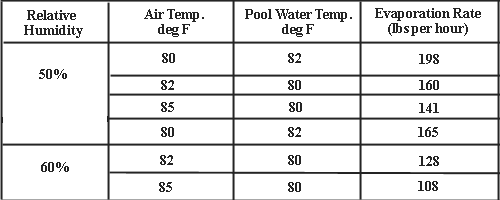As I mentioned in my comment, the heat loss will be largely driven by evaporation. To illustrate, here is a chart that relates surface temperature, relative humidity and wind velocity to rate of evaporation. This is for concrete, but the same basic physics applies:

If we assume that the "surface temperature of the concrete" and temperature of the pool can be equated, then we find the rate of evaporation per unit area for the conditions you gave as "somewhere between 1 and 2 $kg/m^2/hr$". With the latent heat of evaporation of water being around 80 cal/g, and the surface area of your pool at 5 square meters (pretty shallow pool... 1000 gallons isn't very much), the lower end of that range would give you a heat loss of
$$80 \cdot 4.2 \cdot 1000 \cdot 5 J/hr$$
which would require a heat source of about 460 W to maintain. Of course on a sunny day you get about $ 1 kW/m^2$ of heat from the sun (normal incidence), much of which will be reflected. These things are all of roughly the same order of magnitude, so your pool will stay warm on a sunny day with not too much wind. When the wind picks up, and especially when the relative humidity is lower, this gets much worse. As you can see from the graph, a wind of 25 mph will cause 10x more evaporation (for the same conditions) compared to a windless day.
A more authoritative (believable) calculation can be found at http://smud.apogee.net/comsuite/content/ces/?id=1023 - these people deal with energy of pools for a living.
Their page shows (among others) the following table for an indoor pool (so no wind) of 25 yards by 8 lanes:

I didn't do the math, but the numbers look comparable.


